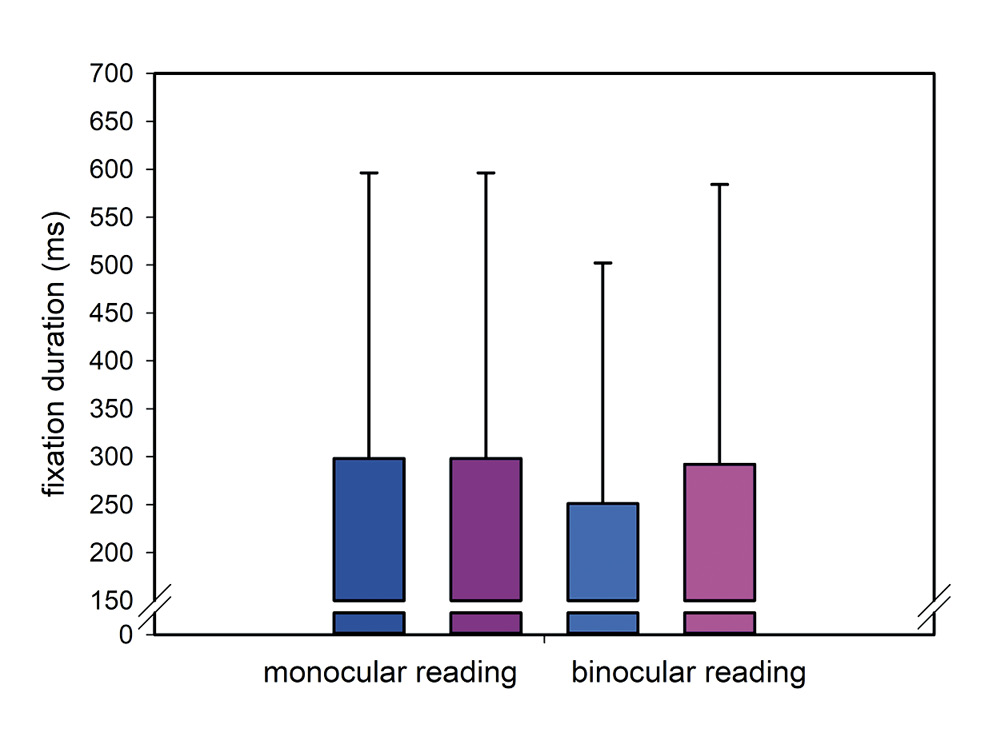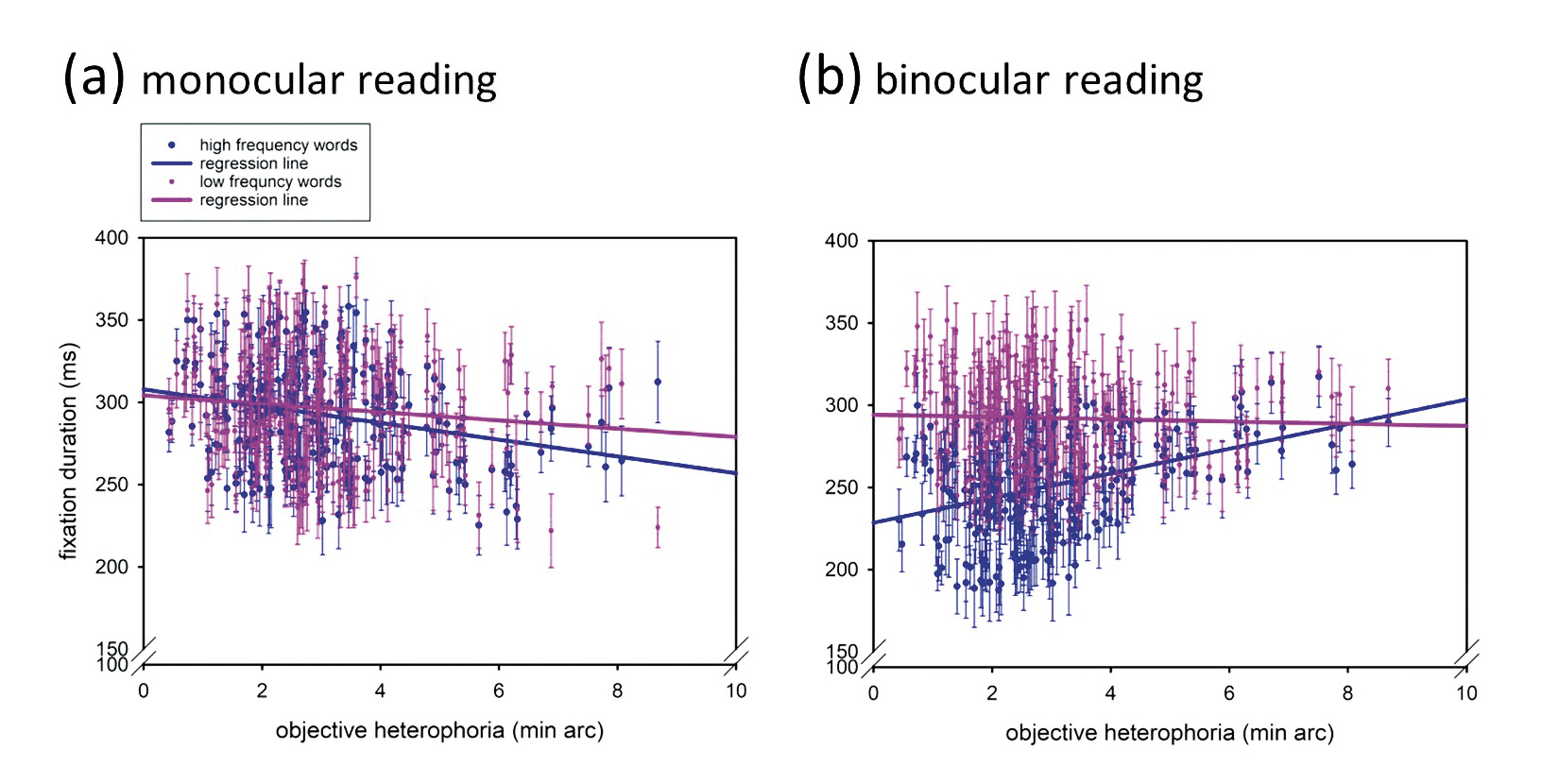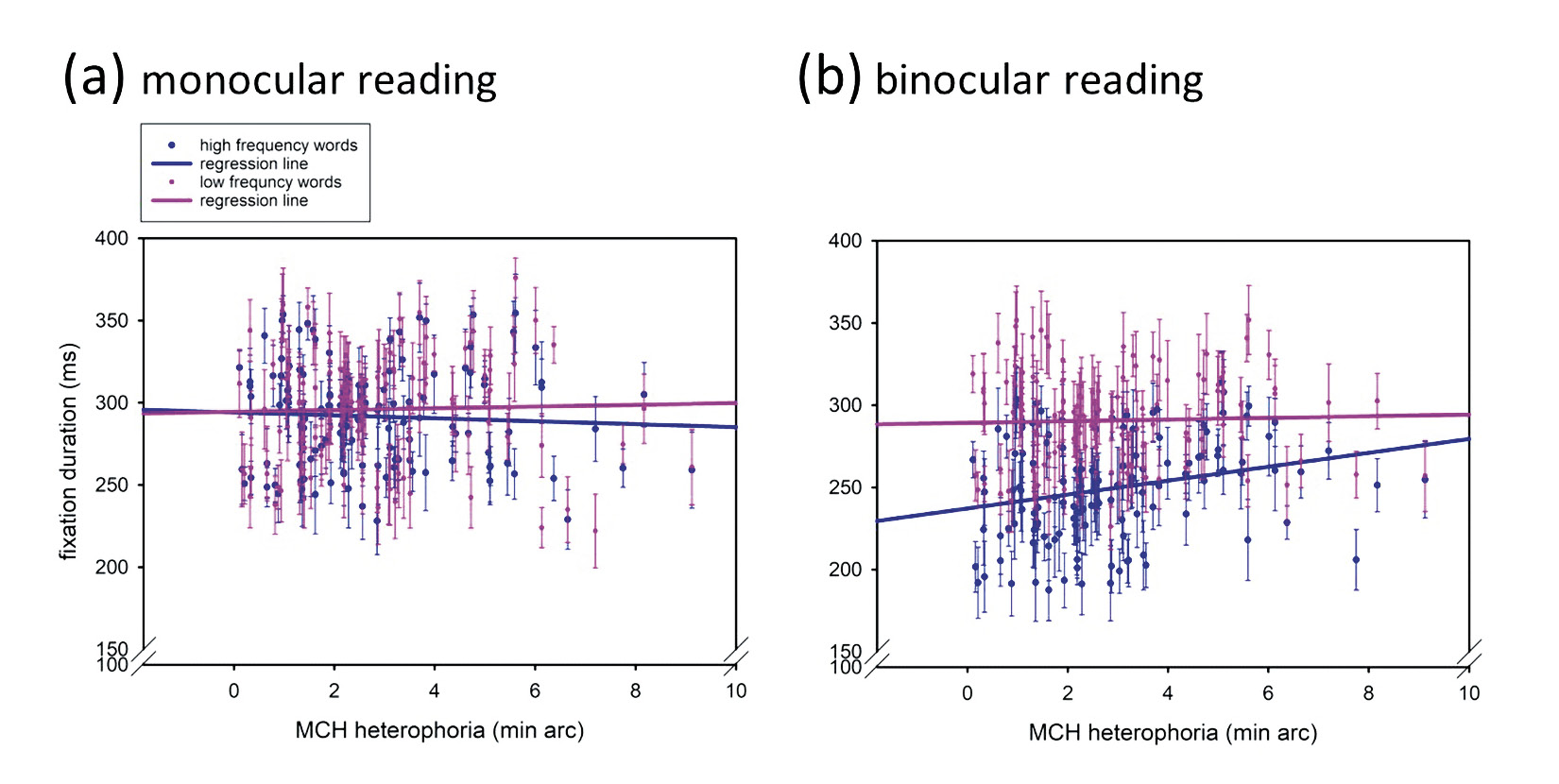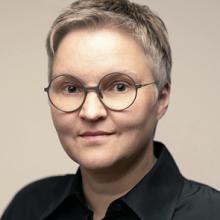How disruptive are monocular reading conditions really?
A new analysis of 260 data sets to describe the binocular advantage in readingPurpose. Based on the fact that reading with both eyes shows a binocular advantage of about 10 % (shorter reading and fixation times compared to monocular reading) with good binocular coordination, the present study aims to investigate the influence of the quality of binocular vision on the effectiveness of reading.
Material and Methods. The binocular eye movements (Eyelink II) of 260 test subjects were reevaluated. All subjects read 60 sentences in German containing a target word occurring either frequently or rarely in this language. Additionally, the reading condition was changed from monocular to binocular for 30 sentences. Furthermore the objective heterophoria and MCH heterophoria for all participants were determined.
Results. In the case of monocular reading conditions, there was only a weak general word-frequency effect (b = 7.21; t = 1.91; p = 0.06) but fixation times for frequent words shortened slightly when objective heterophoria increased (b = −4.24; t = −3.82; p < 0.001). For binocular reading conditions, on the other hand, there was a clear word-frequency effect (b = −48.77; t = −6.03; p < 0.001) and, at the same time, an interaction with individual heterophoria (objective: b = 8.19; t = 14.57; p < 0.001; MCH: b = 3.27; t = 4.40; p < 0.001).
Conclusion. Monocular reading conditions can be proven to be disruptive when investigating people with good binocular coordination. However, this effect turns out to be much smaller than what is assumed by many optometrists. People with good binocular coordination clearly show greater benefits when reading with both eyes.
Introduction
Reading a text with both eyes (binocularly) is generally faster than reading it with only one eye (monocularly).1–4 The origins of this advantage lie in sensory fusion, because, when reading with both eyes, by comparing the two images it is possible to differentiate more subtle visual characteristics that are thus processed more efficiently .5–8 Since around 2010, both authors have been intensively studying binocular coordination and the above mentioned binocular advantages in reading, and have been able to confirm that (a) there is a general binocular advantage of around 10 % in reading 1,2,9,10,11 and (b) this advantage changes depending on the quality of binocular coordination, for example with individual heterophoria.2,10,11 In the earlier studies, this was usually objectively measured (individual horizontal heterophoria) as the angle between the visual axes of both eyes when one eye is fixated and the other assumes its resting position (without visual stimulus, at medium brightness).12 Test subjects with greater heterophoria showed a smaller binocular advantage when reading.10 Heterophoria was later measured in detail using three methods (measurement and correction method according to H.-J. Haase (MCH) at a distance of 6 m, Maddox-Wing at 30 cm and objectively with an eye tracker at 60 cm) and it was shown that the relation between a binocular advantage in reading and the size of a heterophoria was most clearly observed when the heterophoria was determined with the Maddox-Wing test or measured objectively with an eye tracker.2 Recently, the authors were able to show in a controlled study involving spectacle wear that test subjects with MCH heterophoria who wore a prismatic MCH correction during 6 months increased their binocular advantage from very low to approximately 50 % of a normal binocular advantage.11
The following questions often arise when discussing the results regarding binocular advantage with optometrists: Is a monocular reading condition possibly a disruptive visual condition for a balanced visual system with good binocular coordination? For example, how does a visual system behave, i.e. how does a person who has always been used to a limited binocular coordination read? In other words, this scepticism could be formulated as: If a binocular advantage is determined by comparing monocular and binocular reading conditions, it could be that the monocular reading condition is so atypical, so unusual for the reading process, that the advantages detected are overestimated. In this sense, a monocular reading condition would be seen as disturbing,
interrupting, i.e. disruptive, for the reading process, and people with limited binocular coordination could react less strongly to such a disruption.
This study gets to the bottom of this question by re-analysing data sets from the last 10 years. This makes it clear that this is not a new study (with, for example, a priori hypotheses), but that it rather specifically addresses a question from the field and compiles data records for an explorative, retrospective analysis to offer a data-based consideration for a further exchange of ideas.
But before discussing these analyses, it is important to consider that the binocular advantage depends on the contrast of the text being read.4,6,11 We can find a binocular advantage of approximately 10 % while reading texts with a high contrast, while a binocular advantage of approximately 25 % is observed when the text contrast is reduced by 90 %. In general, the lower the text contrast, the longer all fixation times when reading. This results in slower reading, both monocularly and binocularly.11
A special feature of binocular advantage can be illustrated further if we consider that a classic word-frequency effect is often observed during reading (i.e. shorter fixation times for words that occur frequently in a language). This reflects the linguistic processing of the text.13,14 If we now factor in contrast into this word-frequency effect, similar effects can be found for low and high contrasts.9 This means that, if the contrast of the text is reduced, everything becomes slower, regardless of whether frequent or rare words are read in the text. Thus, the relatively faster processing of the more frequent words remains.
On the other hand, this latter effect is different if we look at binocular advantage: if the visual situation is changed from binocular to monocular reading, the word-frequency effect disappears (almost) completely.9 This means that the binocular advantage in reading cannot be explained by contrast effects (the authors have shown several times that a classic word-frequency effect varies with the proportion of binocular presentation of the text) In other words: if a subject sees the text parafoveally and binocularly, a word-frequency effect can be demonstrated, however less pronounced. In purely monocular reading the effect can no longer be
observed.1,15,16
This means that text processing while reading benefited noticeably when using both eyes compared to monocular reading conditions. Text processing, or more precisely the linguistic processing of the information seen in a text (in the sense of a word-frequency effect), is therefore less efficient in monocular conditions during reading.1,16 The reasons behind this are still unclear.
Optometrists often anecdotally report that a monocular reading condition may be disruptive for a person with good binocular coordination, whereas a person with poor binocular coordination (purely through habit and practice) may read just as efficiently, meaning the monocular reading condition may not prove as disruptive. For this reason, in this paper, reading conditions from several studies 2,9,10,11,17 are specifically analysed with regard to the word-frequency effect (in order to test text processing efficiency), and heterophoria values of the subjects are also considered as a possible characterisation of binocular coordination.2,10,12 If the absence of a word-frequency effect in monocular viewing conditions is indeed related to the quality of binocular coordination, a word-frequency effect in monocular reading should become more apparent the greater a person‘s heterophoria. At the same time, it can also be tested whether the general reading time (as average fixation time) actually always benefits from good binocular coordination.3,5–8 Based on this, the binocular reading times would increase with poorer binocular coordination and the monocular reading times would always be longer than the binocular reading times for all test subjects.
Material and methods
Study participants
In total, data from 260 participants (28 % men, 72 % women) between the ages of 19 and 35 (mean = 26 ± 5 years) from 5 independent studies and analysed were analyzed again.2,9,10,11,18 In all studies, the participants stated German as their native language, reported no reading and spelling problems and presented a monocular uncorrected visual acuity of 0.8 (or more) at a distance of 60 cm. The uncorrected spherical equivalents varied from −2 to +1.5 D (mean = 0.5 ± 0.15 D), measured monocularly. The (un)cover test and the TNO stereo test (60‘‘ or better) showed no abnormalities. If the test subjects exhibited vertical phoria greater than 1 cm/m and signs of strabismus, they were excluded from their respective study (the data came from studies focussing on horizontal binocular coordination during reading).2,9,10,11,17
To characterize binocular coordination, objective heterophoria (varying from −9 to +5 degrees visual angle) was available for all 260 subjects.12 The heterophoria was measured with an eye tracker (see below) while the subject first fixated a cross binocularly for 2.5 s (binocular fixation phase) and then looked at the same cross monocularly for 15 s without transition (monocular fixation phase; background presentation with medium brightness for the eye without visual stimulus in the haploscope). Both phases were repeated several times, and the eye was changed in the monocular fixation phase. The objective heterophoria was ultimately determined as the difference between the final fixation phase of both fixation phases and averaged over the repetitions. For a subgroup of 154 subjects, horizontal heterophoria was determined according to the measurement and correction method of
H.-J. Haase (MCH) at a visual distance of 6 m, in accordance with the “Guidelines for the application of the measurement and correction method of H. J. Haase” (www.ivbs.org); horizontal heterophoria was between −18 and +12 cm/m with a mean value of M = 3 (± 1.5) cm/m.
All studies were conducted in accordance with the Declaration of Helsinki and approved by an ethics committee.
The reading task
In all studies, the participants read 60 German sentences (8 to 13 words in length and between 55 and 75 characters long, based on the Potsdam Sentence Corpus 15), which were presented in blocks of 5. Each sentence was read only once and randomly assigned to one of the reading conditions (monocular or binocular). The sentences were presented in black Courier New font (12 point) on a white background with a luminance of around 50 cd/m2 and with an ambient illuminance of between 60 and 120 lux. The viewing distance to the text was always 60 cm. There was a break between the blocks so that the test subjects could relax their eyes for a few minutes. In one third of the tests, the study participants answered a question about the content of the sentence they had just read (answer with a mouse click) in order to check their comprehension of the text. If the percentage of incorrect answers exceeded 10 %, the data of the respective test subject was excluded from the analysis. This was the only way to guarantee that the study participants completed the reading task at a consistently good level for all conditions.
In the course of each study, measurements of the movements of both eyes were taken for each person when reading monocularly and binocularly. The haploscope used for all studies and text presentations allowed the monocularly read text to be presented without interference.6,11
Word frequencies
30 sentences were presented per reading condition (monocular and binocular). Fifteen in each condition contained a central target word (8 letters long), which always followed a 5- or 6-letter adjective. This target word began directly in the centre of the screen and was always a noun. Celex2-German version 2.0 was used to categorise the target words into words with a high word frequency (frequent words: 86 to 596 per million) and with a low word frequency (rare words: 1 to 20 per million) in German.19 In addition, all sentences were tested for predictability of the occurrence of the target word. An average predictability of 1.8 % was found for words with a high word frequency and 0.1 % for words with a low word frequency. This difference was not statistically significant(t < 1).14
Recording and analysing eye movements
All horizontal eye movements during reading were recorded objectively with the video-based EyeLink II (SR Research Ltd, Osgoode ON, Canada; sampling frequency 500 Hz) and separately for both eyes. Calibration for the EyeLink II was always done monocularly, whereby the study participants fixated a cross that appeared for 1000 ms at one of three horizontal positions (distance: 8 degrees). The monocular presentation (right or left eye) was changed randomly. Further details on the calibration and procedure of the eye movement measurements have been described in several previous studies and can be found there.2,11
First, the saccades and fixations were extracted from all eye-movement data using the version signal [(left eye + right eye) / 2] (more than 50,000 individual observations in total) and the fixation time was calculated for each fixation. Additional extracted parameters describing binocular coordination are reported and presented in the original articles. For the monocular and binocular reading conditions, the fixations (“first fixations” 13,14) on frequent and infrequent target words were extracted for each person in the next step and the fixation times were calculated
All heterophoria values were included in the analyses as absolute values (regardless of their direction: “eso”, “ortho” or “exo”), as only a general characterisation of binocular coordination is considered here (for more extensive data analyses, a larger sample with more variations in heterophoria is required, especially in the higher values).
The reading conditions (monocular versus binocular) and word frequency (frequent versus rare) were included as fixed factors in a mixed linear model in R,19–22 while the sentences and test subjects were included in the model as random factors. The estimated fixed effects (b) with standard error (SE), t-value and the corresponding p-value are listed below. The fixed effects are interpreted as coefficients analogous to the regression analysis. As they are estimated based on the available data, an additional consideration of the standard errors is helpful in order to assess the quality of the estimate. Furthermore, these effects can be compared directly with reports in the literature (i.e. with other studies on similar topics), which allows an assessment of the significance of the effect and its practical relevance. Significance considerations play a secondary role in such model adjustments; the main focus here being the detection (modelling) of systematic effects that can be statistically assigned to a source independently of the material (here, the words) and the participants.

Results
First, it was shown that fixation times averaged around 280 ms (± 30 ms), which was consistent with previous observations. As can be seen in Figure 1, the fixation time changed essentially depending on the change in word frequency: the difference between rare words (295 ms ± 31 ms) and frequent words (251 ms ± 29 ms) showed a clear word-frequency effect of approx. 40 ms, which corresponds to a reduction in fixation times of approx. 15 %. At the same time, the mean fixation times were reduced from 292 ms (± 30 ms) for monocular reading to 271 ms (± 32 ms) for binocular reading, which corresponds to a general binocular advantage of approx. 8 %.

In the next step of the data analysis, objective heterophoria was considered as a variable using a mixed linear model, and a significant interaction between the three factors of reading condition (monocular versus binocular), word frequency (frequent versus rare) and objective heterophoria (b = 12.44; SE = 1.23; t = 10.09; p < 0.001) was found in addition to all three main effects (reading condition, word frequency, heterophoria). This means that the patterns in the data changed with a change in all three variables. In order to be able to describe the individual effects, the data for the reading conditions (main effect from binocular to monocular reading: b = 28.08; SE = 6.60; t = 6.03; p < 0.001) were split and separate mixed linear models were calculated for monocular and binocular reading (see Figure 2).
For the monocular reading conditions, only one trend showed a weak word-frequency effect (longer fixation times for rarer words: b = 7.21; SE = 3.76; t = 1.91; p = 0.06), but there was an interaction between word frequency and objective heterophoria. If heterophoria increased, the fixation times for frequent words were reduced (b = −4.24; SE = 1.11; t = −3.82; p < 0.001). As can be clearly seen from the blue line in Figure 2a, the fixation times decrease slightly when heterophoria increases.

For the binocular reading conditions, the pattern was different, as expected: on the one hand, a clear word-frequency effect (b = −48.77; SE = 1.90; t = −6.03; p < 0.001), with shorter fixation times for more frequent words could be observed and, at the same time, the pattern showed an interaction with individual heterophoria (b = 8.19; SE = 0.56; t = 14.57; p < 0.001). As can be clearly seen in Figure 2b, the fixation time for more frequent words became longer with increasing heterophoria and for large heterophoria almost reached the level of fixation times for the rare words.
The analyses for MCH heterophoria showed a similar pattern (Figure 3), although no significant interaction of word frequency and MCH heterophoria was found for the monocular reading conditions (b = 2.06; SE = 1.21; t = 1.69; p = 0.10). The interaction effect was also significantly smaller in binocular reading (b = 3.27; SE = 0.74; t = 4.40; p < 0.001).
Discussion
The current study again revealed the already documented binocular advantage of shorter fixation in binocular reading compared to monocular reading.1,2,10–12 At the same time, a clear word-frequency effect could also be shown in the data,1,9,13 which was not recognisable under monocular conditions, but was clearly seen in binocular conditions. As determined in earlier studies under other measurement conditions,1,15,16 it is rather the fixation times for frequently occurring words that change with the alteration in reading conditions from binocular to monocular. The reason for this is certainly that, although the direction and duration of eye movements during reading are controlled centrally by the text processing system, the fixation times per fixation are not arbitrarily long.13,14 Here, a general rhythm in eye movements seems to prevent fixations that are too long (one fixates a word several times rather than lingering too long on one word). For this reason, word-frequency effects are not evident in the first fixations on words. If other fixation measures are considered, smaller word-frequency effects can be observed.1,9,13,15,16
What was interesting, however, was the dependence of the word-frequency effect on the level of individual heterophoria 2,10 which we considered as a characterisation of binocular coordination: the higher the heterophoria, the more likely a word-frequency effect was found in monocular reading. This observation supports the argument of many optometrists that monocular reading conditions are less disruptive for individuals with limited binocular coordination. However, it is also clear from the data used that this advantage is quite small, with around 2 % reduction in fixation times or just under 25 % of a typical word-frequency effect. Moreover, it becomes clear under binocular reading conditions how large and clear a word-frequency effect of approx. 40 ms per fixation on average can be when the heterophorias are small (Figure 2 and Figure 3). However, a critical comparison with test subjects who actually only have monocular vision is still pending.
In conclusion, it can be stated that people with limited binocular coordination do not read as quickly as people without such limitations, as can be surmised from the literature.1,7–10 Another interesting result is that in the analyses on which this study is based, both objective heterophoria and MCH heterophoria showed similar results, even if the effects for MCH heterophoria were smaller and weaker overall.2
Conclusion
Monocular reading conditions are (slightly) disruptive when looking at people without limited binocular coordination. However, this effect turns out to be much smaller than expected. People with good binocular coordination clearly show greater advantages when reading with both eyes.
Image: Copyright by Prof. Dr. Stephanie Jainta
Conflict of interest
The authors have no conflict of interest regarding the methods and devices mentioned in this article. Individual studies that served as the basis for this new data analysis were funded by the German Research Foundation (DFG Ja 747/6-1; DFG Ja 1921/1-1,2-1,3-1), the Swiss National Science Foundation (SNF; grant no. 320030_172965) and financially supported by the International Association for Binocular Vision (IVBS).
